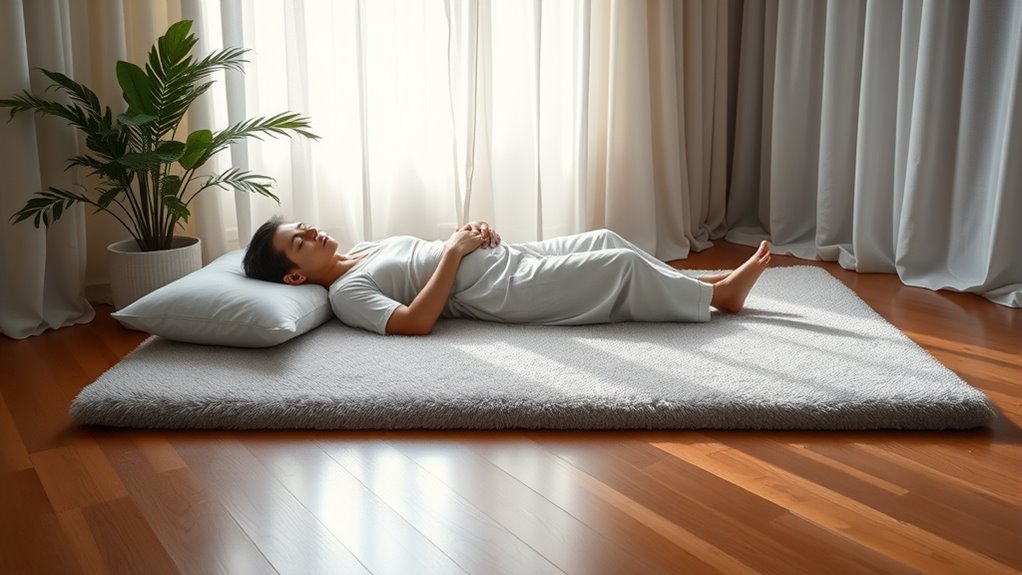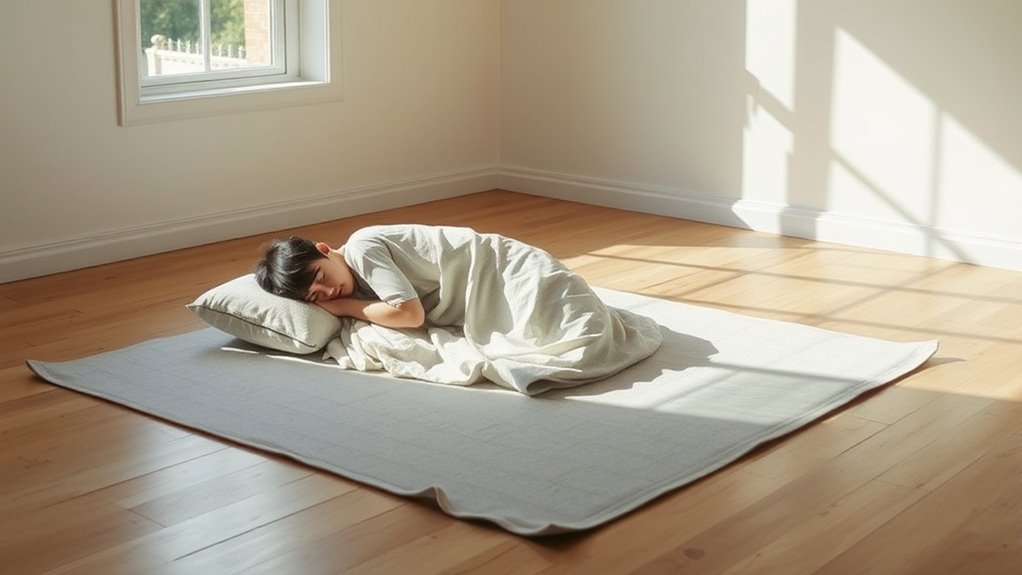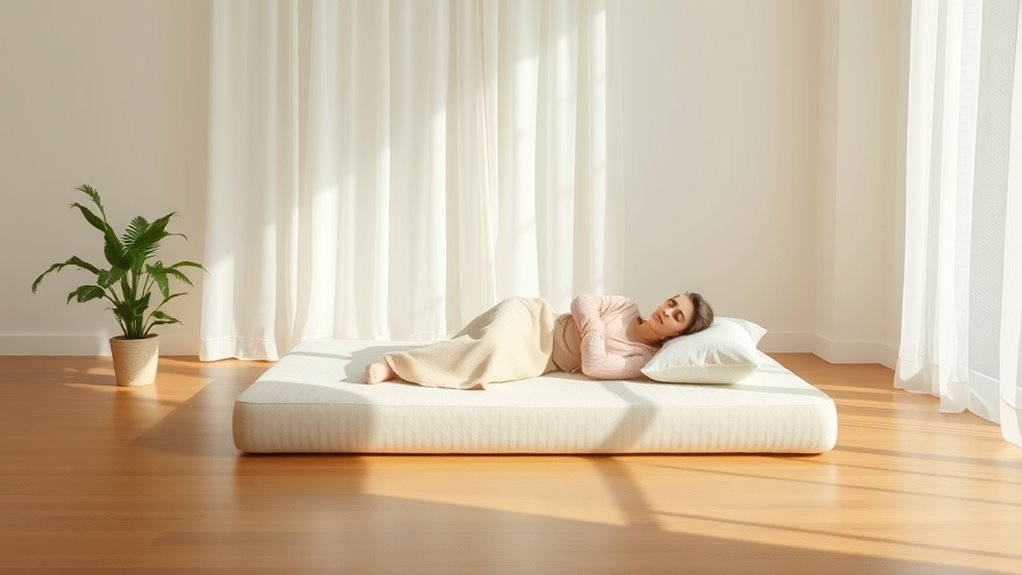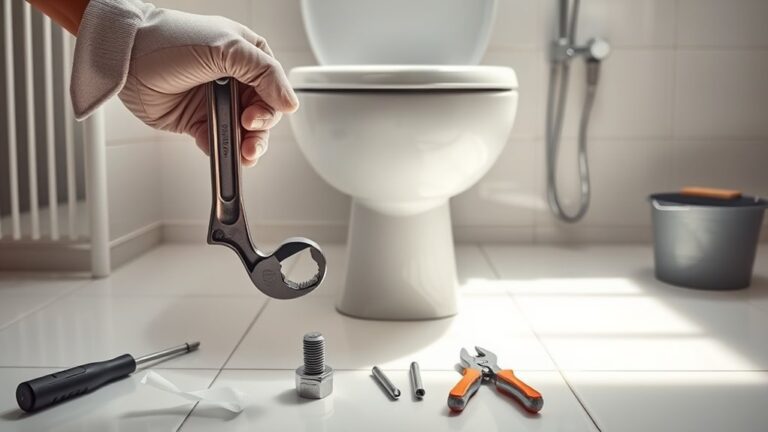Sleeping on the floor can help back pain by providing firm support that promotes natural spinal alignment and reduces muscle tension from poor posture. This firm surface distributes your body weight evenly, potentially easing stress on spinal structures. However, initial discomfort and pressure on joints are common, and hygiene or preexisting conditions may require caution. If you want to understand how to safely shift and explore alternative pain relief methods, there’s more detailed guidance available.
Understanding Back Pain and Its Causes

Although back pain is a common complaint, understanding its underlying causes requires a detailed examination of anatomical structures and biomechanical factors. You need to take into account how muscle tension contributes to discomfort, often resulting from repetitive strain or poor postural habits. Prolonged misalignment increases stress on spinal ligaments, intervertebral discs, and facet joints, exacerbating pain. Your habitual posture influences the distribution of mechanical loads on the spine, potentially leading to compensatory muscle imbalances. These imbalances cause localized muscle tension, restricting mobility and triggering nociceptive pain signals. Evidence shows that addressing these biomechanical contributors is essential for effective management. By recognizing how your muscle tension and postural habits interplay, you gain insight into tailored interventions that promote spinal freedom and reduce persistent back pain, setting the foundation for evaluating interventions like sleeping surfaces.
How Sleeping Surfaces Affect Spinal Health
Because your sleeping surface directly influences spinal alignment, it plays an essential role in either alleviating or exacerbating back pain. Mattress firmness must support your natural spinal curvature while accommodating your preferred sleeping posture. Too soft a surface may cause sagging; too firm may create pressure points. Selecting the right firmness promotes balanced load distribution and ideal intervertebral spacing.
| Sleeping Surface | Mattress Firmness | Effect on Spinal Health |
|---|---|---|
| Floor | Very firm (no cushioning) | May improve alignment if posture is correct; risks pressure points |
| Memory Foam | Medium-firm | Conforms well, supports curves, reduces pressure |
| Innerspring | Varies (soft to firm) | Can lack contouring, may misalign spine |
| Hybrid | Medium | Balances support and contouring |
| Air Mattress | Adjustable firmness | Customizable, but may lack stability |
Your choice impacts spinal biomechanics and back pain outcomes.
The Theory Behind Sleeping on the Floor for Back Pain

When you sleep on the floor, your spine may maintain a more natural alignment due to the firmness of the surface, which can reduce abnormal curvature linked to back pain. This firm support also helps distribute body weight evenly, minimizing pressure points that often cause discomfort. Understanding these mechanisms is key to evaluating whether floor sleeping could benefit your back health.
Spinal Alignment Benefits
If you’re dealing with back pain, understanding how spinal alignment affects discomfort is essential. Sleeping on the floor offers firm spinal support, which can promote alignment improvement by preventing unnatural curvatures caused by soft mattresses. This can reduce strain on muscles and ligaments, potentially alleviating chronic pain.
| Factor | Effect on Spinal Alignment |
|---|---|
| Firm Surface | Maintains neutral spine posture |
| Soft Mattress | May cause spine sinking |
| Floor Sleeping | Enhances alignment improvement |
Pressure Point Relief
Alongside spinal alignment, managing pressure points plays a significant role in mitigating back pain. When you sleep on the floor, the firm surface provides minimal contouring, which affects how pressure is distributed across your body. This can influence the effectiveness of pressure point techniques designed to alleviate discomfort. Your sleeping position directly impacts which areas bear the most weight and pressure.
Consider these factors:
- Even pressure distribution: A firm base helps prevent excessive pressure on localized points.
- Reduced muscle tension: Proper sleeping position on the floor can relax muscles around sensitive areas.
- Improved circulation: Minimizing pressure on key points enhances blood flow, aiding tissue recovery.
Potential Benefits of Sleeping on the Floor
Although sleeping on the floor may initially seem uncomfortable, research suggests it can offer several benefits for back pain management by promoting spinal alignment and reducing pressure points. By providing a firm, even surface, floor comfort helps maintain a neutral sleep posture, preventing unnatural spinal curvature that often exacerbates pain. This firmness supports the natural S-shape of the spine, distributing body weight evenly and minimizing localized stress on muscles and joints. Additionally, floor sleeping can enhance proprioceptive feedback, improving body awareness and encouraging healthier posture habits during waking hours. Adopting this sleep posture may reduce muscle tension and inflammation linked to poor sleeping surfaces. For those seeking freedom from chronic back pain, integrating floor sleeping could be a practical, evidence-based strategy aligned with biomechanical principles.
Possible Risks and Discomforts of Floor Sleeping

When you start sleeping on the floor, you might experience initial discomfort or increased pain due to your body adjusting to the firmer surface. Prolonged pressure on joints like hips and shoulders can exacerbate soreness or cause numbness. Additionally, floors can harbor dust, allergens, and microbes, raising concerns about hygiene and cleanliness that could affect your overall health.
Initial Discomfort and Pain
Several individuals report experiencing initial discomfort and increased pain when shifting to sleeping on the floor, particularly in the lower back and pressure points such as the hips and shoulders. This initial discomfort often stems from the abrupt change in support and spinal alignment compared to conventional mattresses. To manage this pain effectively, consider these evidence-based strategies:
- Gradually adapt by incorporating floor sleeping for short periods to allow musculoskeletal adaptation.
- Use thin padding or supportive mats to reduce pressure without negating the firmness benefits.
- Implement targeted stretches and strengthening exercises aimed at spinal stabilization and flexibility.
Understanding that initial discomfort is a common response can help you approach floor sleeping with realistic expectations and appropriate pain management techniques, ultimately facilitating a freer, more comfortable sleep experience.
Pressure on Joints
Because sleeping on a firm, unyielding surface alters load distribution, you may experience increased pressure on joints such as the hips, knees, and shoulders. This pressure can lead to joint stiffness and discomfort, especially if your body lacks adequate pressure relief. Unlike softer mattresses, the floor offers minimal cushioning, which may exacerbate localized stress on bony prominences.
| Joint | Common Pressure Points | Potential Impact |
|---|---|---|
| Hips | Greater trochanter | Increased stiffness |
| Knees | Patella | Discomfort during flexion |
| Shoulders | Acromion process | Reduced mobility |
To maintain joint health while floor sleeping, consider using thin padding to optimize pressure relief and minimize joint stiffness.
Hygiene and Cleanliness Issues
Although sleeping on the floor may offer certain orthopedic benefits, it can also expose you to increased hygiene and cleanliness concerns. Without proper floor sanitation, you risk contact with dust, allergens, and microbial contaminants that accumulate near the floor surface. Maintaining clean bedding becomes essential to create a protective barrier and reduce exposure to these irritants. To minimize hygiene issues when floor sleeping, focus on:
- Regularly disinfecting and vacuuming the floor area to limit microbial load and dust accumulation.
- Using hypoallergenic, washable clean bedding materials that can be laundered frequently.
- Ensuring adequate ventilation to reduce moisture buildup and inhibit mold growth.
What Medical Experts Say About Floor Sleeping
While floor sleeping has gained popularity as a potential remedy for back pain, medical experts remain cautious due to limited empirical evidence supporting its benefits. Current medical recommendations emphasize individualized assessment before adopting floor sleeping, as spinal alignment and pressure distribution vary widely among individuals. Some studies suggest firmer surfaces may reduce lower back discomfort, yet no consensus exists on floor sleeping as a universally effective intervention. Experts warn that abrupt changes to sleeping surfaces without professional guidance could exacerbate symptoms, especially in those with preexisting spinal conditions. If you’re considering floor sleeping, medical advice typically involves evaluating your specific back pathology and sleep ergonomics. Ultimately, medical experts advocate evidence-based approaches rather than anecdotal trends when addressing back pain management.
Tips for Transitioning to Sleeping on the Floor
When you decide to shift to floor sleeping, it’s essential to proceed gradually to allow your musculoskeletal system to adapt to the firmer surface. Abrupt changes can cause discomfort or exacerbate existing pain. Start by integrating appropriate sleeping gear and adequate floor cushioning to maintain spinal alignment and pressure distribution. Consider these tips:
- Use a thin, supportive mat or yoga mat as initial floor cushioning to reduce impact without compromising firmness.
- Gradually decrease mattress thickness over weeks to allow your body to acclimate.
- Monitor your body’s response daily, adjusting sleeping positions and floor cushioning accordingly.
This evidence-based approach guarantees you maintain freedom of movement while minimizing strain. Proper shift respects your anatomy and promotes sustainable back health improvements.
Alternative Solutions for Alleviating Back Pain
Since floor sleeping may not suit everyone, exploring alternative solutions for alleviating back pain is essential. You might consider acupressure therapy, which applies targeted pressure to specific points, stimulating neural pathways that can reduce muscle tension and improve circulation. Evidence suggests this method can modulate pain perception effectively. Additionally, incorporating yoga stretches into your daily routine enhances spinal flexibility and strengthens core muscles, providing structural support vital for back health. Research supports that consistent practice reduces stiffness and improves posture, thereby alleviating discomfort. Both approaches offer non-invasive, drug-free options that empower you to manage pain with autonomy. By integrating acupressure therapy and yoga stretches, you can tailor a regimen that fits your lifestyle, promoting sustained relief without relying solely on floor sleeping or medication.
Personal Experiences and Testimonials on Floor Sleeping
Although scientific studies provide valuable insights into floor sleeping’s effects on back pain, personal experiences offer practical perspectives that can guide your decision-making. Floor sleeping experiences and personal testimonials reveal a spectrum of outcomes, highlighting the importance of individual variability in response. Many users report initial discomfort, followed by gradual improvement in spinal alignment and reduced pain intensity. Others note no significant change or increased stiffness.
Key observations from personal testimonials include:
- Gradual adaptation period ranging from days to weeks
- Enhanced postural awareness leading to conscious spinal support
- Potential exacerbation of pre-existing conditions without proper technique
These insights suggest that while floor sleeping may benefit some, it requires careful implementation and monitoring. Your freedom to choose should be informed by both empirical evidence and authentic user feedback.




